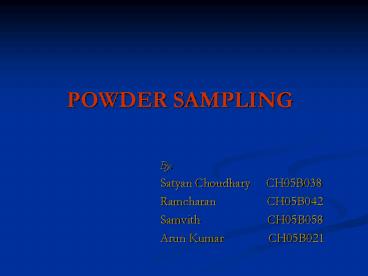POWDER SAMPLING - PowerPoint PPT Presentation
1 / 26
Title:
POWDER SAMPLING
Description:
Method used : Coning and Quartering process. Sampling stored materials ... Cone & quarter. Relative Standard Deviation (%) Method. Sampling technique comparison ... – PowerPoint PPT presentation
Number of Views:1323
Avg rating:3.0/5.0
Title: POWDER SAMPLING
1
POWDER SAMPLING
- By
- Satyan Choudhary CH05B038
- Ramcharan CH05B042
- Samvith CH05B058
- Arun Kumar CH05B021
2
Sampling
- Sampling is the process of securing a
representative portion of materials for the
purpose of gaining information regarding the
type, quality, or composition, and therefore the
acceptability and unit value of the total lot
inspected by investigation of the part.
3
Fundamentals of Sampling
- Sample for measurement should be representative
of the bulk in particle size and relative
fraction of their various constituents . - Total sampling error errors due to the primary
sampling subsequent sample dividing errors in
the analysis itself - Accurate sampling depends on its extent of being
biased , that is error of sampling is random
variable about the true mean . - Differences between a sample and bulk may be
attributed to the expected difference on the
statistical basis
4
Major sampling errors
- Errors due to segregation of the bulk , this
depends on the history of the powder and can be
minimized by suitable mixing and building up the
sample from large number of increments - Statistical errors that cannot be prevented. Even
for an ideal random mixture the quantitative
distribution in samples of a given magnitude is
not constant but is subject to random
fluctuations. It can be pre-estimated and reduced
by increasing the sample size
5
Sample selection
- Samples are withdrawn from a population to
estimate certain characteristics of that
population and to establish confidence limits for
that characteristics - If several samples are taken their
characteristics will vary and if these samples
are representative, the expected variation can be
estimated from statistical analysis but equipment
efficiency will also introduce some errors
6
- Different stages of sample reduction (depending
on their weight)
7
Segregation
- Free flowing powders tend to segregate during
handling and storage, hence spot samples are
rarely representative . - Cohesive powders tend to retain their
characteristics during handling but if they are
segregated during manufacture or packaging they
will tend to remain segregated - If material is fed into containers and conveyor
belts it might lead to vertical and horizontal
segregation
8
Segregation in free flowing powders
9
Golden Rules of Sampling
- Powder should always be sampled when in motion.
- The whole of stream of powder should be taken for
many short increments of time in preference to
part of the stream being taken for the whole of
time. - e.g. for a stream
flowing through a pipe , the entire cross
sectional area should be taken for sampling at
repeated intervals rather than a part of cross
sectional area at all times
10
Sampling stored materials
- Sampling stored non flowing materials
- Non flowing materials consist of cohesive
powders, sticky materials , moist materials or
fibrous solids. - A pre-supposition is that the powder was mixed
before storage - Sampling accuracy improves if several samples
are taken - Equipment used Sampling Spear (Thief), Self
burrowing probes
11
Sampling stored materials
- Sampling from heaps
- Method used Coning and Quartering process
12
Sampling stored materials
- Sampling stored bulk free-flowing powders
- best if avoided !!! (because of the severe
segregation ) - Sampling from bags and drums
- Sampling from trucks and railcars
13
Sampling flowing streams
- Sampling from a conveyor belt
- The best position for collecting the sample is
where the materials falls in stream from the end
of the belts. - Sampling may be continuous or intermittent
14
Sampling flowing streams
- Point Samplers
- Sampling from falling streams
15
Sampling flowing streams
- Traversing Cutters
- In-line Sampling
16
Sample Reduction
- (gross sample ? laboratory sample)
- The gross sample is frequently too large to be
handled easily and has to be reduced to a more
convenient weight - Methods employed should conform with the golden
rules of sampling - Some methods for Sample Reduction
- Scoop sampling
17
Sample Reduction
- Cone and Quartering
- Table Sampling
- Chute Splitting
18
Sample Reduction
- Spinning rifflers
19
Sampling technique reliability
20
Sampling technique comparison
21
Weight of sample required
- The minimum weight of the gross sample may be
calculated using the following formula (error
obtained is within pre-designated limits) - - Ms ½ (?/si2) (1/wt 2) dt3 x 103
- Ms limiting weight in gm
- ? powder density (g/cm3 )
- si2 variance of the tolerated
sampling error - wt fractional mass of the coarsest
size class being sampled - dt3 arithmetic mean of the cubes of
the extreme diameter (cm3 )
22
Weight of sample required
- For sampling a moving stream of powder, the gross
sample is made up of increments. The minimum
incremental weight - Ms µowo/?o
- where,
- Ms average mass of the
increment - µo average rate of flow
- wo cutter width for a
traversing cutter - ?o the cutter velocity
23
Sample containers (used for storing samples)
- A large range of sample containers, made from a
variety of materials are available for a wide
range of applications. - Size from 5ml upwards
- Transparent containers available
- Screw caps or simple push on lids
24
Examples of some sampling equipment used in
industry
- UP Free Glide In-line Powder Sampler for
installation in a down pipe - ? Guaranteed not to get stuck during
operation - ? Suitable for in-line sampling of both free
flowing and cohesive powders - ? Automatic and manual versions available
25
Bibliography
- Powder sampling and particle size determination
by T. ALLEN - http//www.sampling.co.uk/guide
- http//www.pharmtech.com/pharmtech/data
- www.dnsc.dla.mil/iamthekey
- http//www.particlescic.com
- Video and images from Google search
26
Thank You































